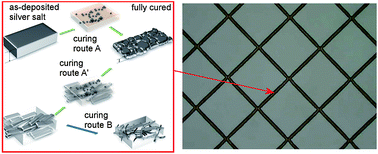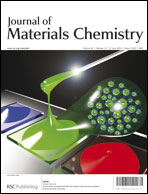Resistivity transition mechanism of silver salts in the next generation conductive ink for a roll-to-roll printed film with a silver network†
Abstract
As the small size display market rapidly expands with the advent of smart phones and tablets, the industrial demand for a low cost transparent conductive film instead of an ITO sputtered one has expedited the development of a roll-to-roll printed one with a low temperature processable and highly conductive ink. The conventional conductive ink based on metallic nanoparticles capped with a polymeric dispersant, however, has difficulties in achieving high conductivity at a low curing temperature due to the unwanted residue of a polymeric dispersant. Therefore, a new kind of conductive ink was developed, where a silver salt replaces the role of a polymeric dispersant and also enriches the overall metallic content. The key to this new generation of conductive ink leans on the selection of a low temperature processable silver salt and the selection process of silver salts was on the basis of their thermogravimetric thermograms with the common belief that the thermogravimetric thermogram of a silver salt is coupled with its resistivity transition and final resistivity. In contrast to this common belief, our results show that the thermogravimetric behaviours of silver salts have little influence on their resistivity transition and final resistivity. With our comprehensive studies using various isomeric silver salts, we here suggest that the more persuasive and leading factors in determining the resistivity transition behaviour of a silver salt are stack integrity, phase transition, and the exothermic band in the differential scanning calorimetric thermogram. The next generation conductive ink with the most suitable silver salt was gravure-offset printed on a transparent and flexible film. Its sheet resistance after being cured at 150 °C is as low as 1 Ω □−1 with the line width of 20 μm and the optical transmittance of 85% and above.


 Please wait while we load your content...
Please wait while we load your content...